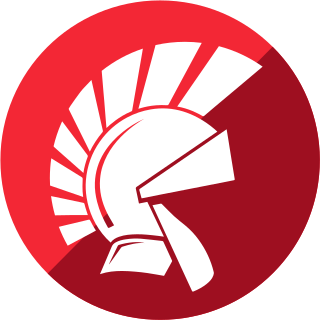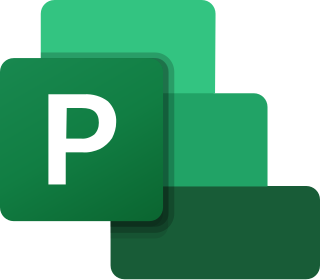An integrated development environment (IDE) is a software application that provides comprehensive facilities to computer programmers for software development. An IDE normally consists of at least a source code editor, build automation tools and a debugger. Some IDEs, such as NetBeans and Eclipse, contain the necessary compiler, interpreter, or both; others, such as SharpDevelop and Lazarus, do not.

Microsoft Excel is a spreadsheet developed by Microsoft for Windows, macOS, Android and iOS. It features calculation or computation capabilities, graphing tools, pivot tables, and a macro programming language called Visual Basic for Applications (VBA). Excel forms part of the Microsoft Office suite of software.

Microsoft Access is a database management system (DBMS) from Microsoft that combines the relational Access Database Engine (ACE) with a graphical user interface and software-development tools. It is a member of the Microsoft 365 suite of applications, included in the Professional and higher editions or sold separately.
Visual Basic for Applications (VBA) is an implementation of Microsoft's event-driven programming language Visual Basic 6.0 built into most desktop Microsoft Office applications. Although based on pre-.NET Visual Basic, which is no longer supported or updated by Microsoft, the VBA implementation in Office continues to be updated to support new Office features. VBA is used for professional and end-user development due to its perceived ease-of-use, Office's vast installed userbase, and extensive legacy in business.
HCL Notes and HCL Domino are the client and server, respectively, of a collaborative client-server software platform formerly sold by IBM, now by HCL Technologies.

Genera is a commercial operating system and integrated development environment for Lisp machines created by Symbolics. It is essentially a fork of an earlier operating system originating on the Massachusetts Institute of Technology (MIT) AI Lab's Lisp machines which Symbolics had used in common with Lisp Machines, Inc. (LMI), and Texas Instruments (TI). Genera was also sold by Symbolics as Open Genera, which runs Genera on computers based on a Digital Equipment Corporation (DEC) Alpha processor using Tru64 UNIX. In 2021 a new version was released as Portable Genera which runs on DEC Alpha Tru64 UNIX, x86_64 and Arm64 Linux, x86_64 and Apple M1 macOS. It is released and licensed as proprietary software.

Visual Basic, originally called Visual Basic .NET (VB.NET), is a multi-paradigm, object-oriented programming language, implemented on .NET, Mono, and the .NET Framework. Microsoft launched VB.NET in 2002 as the successor to its original Visual Basic language, the last version of which was Visual Basic 6.0. Although the ".NET" portion of the name was dropped in 2005, this article uses "Visual Basic [.NET]" to refer to all Visual Basic languages released since 2002, in order to distinguish between them and the classic Visual Basic. Along with C# and F#, it is one of the three main languages targeting the .NET ecosystem. As of March 11, 2020, Microsoft announced that evolution of the VB.NET language has concluded.
FileMaker is a cross-platform relational database application from Claris International, a subsidiary of Apple Inc. It integrates a database engine with a graphical user interface (GUI) and security features, allowing users to modify a database by dragging new elements into layouts, screens, or forms. It is available in desktop, server, iOS and web-delivery configurations.

Delphi is a general-purpose programming language and a software product that uses the Delphi dialect of the Object Pascal programming language and provides an integrated development environment (IDE) for rapid application development of desktop, mobile, web, and console software, currently developed and maintained by Embarcadero Technologies.
Clarion is a commercial, proprietary, fourth-generation programming language (4GL), multi-paradigm, programming language and integrated development environment (IDE) from SoftVelocity used to program database applications. It is compatible with indexed sequential access method (ISAM), Structured Query Language (SQL), and ActiveX Data Objects (ADO) data access methods, reads and writes several flat file desktop database formats including ASCII, comma-separated values (CSV), DOS (binary), FoxPro, Clipper, dBase, and some relational databases via ODBC, Microsoft SQL Server, Sybase SQL Anywhere, and Oracle Database through the use of accelerated native database drivers, and XML, Clarion can be used to output to HTML, XML, plain text, and Portable Document Format (PDF), among others.

Windows Forms (WinForms) is a free and open-source graphical (GUI) class library included as a part of Microsoft .NET, .NET Framework or Mono Framework, providing a platform to write client applications for desktop, laptop, and tablet PCs. While it is seen as a replacement for the earlier and more complex C++ based Microsoft Foundation Class Library, it does not offer a comparable paradigm and only acts as a platform for the user interface tier in a multi-tier solution.

Microsoft Project is a project management software product, developed and sold by Microsoft. It is designed to assist a project manager in developing a schedule, assigning resources to tasks, tracking progress, managing the budget, and analyzing workloads.
Quicken is a personal finance management application originally developed and offered by Intuit, Inc. Intuit sold Quicken to H.I.G. Capital in 2016, and H.I.G. sold Quicken to Aquiline Capital Partners in 2021.
The Access Database Engine is a database engine on which several Microsoft products have been built. The first version of Jet was developed in 1992, consisting of three modules which could be used to manipulate a database.

Lazarus is a free cross-platform visual integrated development environment (IDE) for rapid application development (RAD) using the Free Pascal compiler. Its goal is to provide an easy-to-use development environment for programmers developing with the Object Pascal language, which is as close as possible to Delphi.

The original Visual Basic is a third-generation event-driven programming language from Microsoft known for its Component Object Model (COM) programming model first released in 1991 and declared legacy during 2008. Microsoft intended Visual Basic to be relatively easy to learn and use. Visual Basic was derived from BASIC and enables the rapid application development (RAD) of graphical user interface (GUI) applications, access to databases using Data Access Objects, Remote Data Objects, or ActiveX Data Objects, and creation of ActiveX controls and objects.

Visual Studio is an integrated development environment (IDE) from Microsoft. It is used to develop computer programs including websites, web apps, web services and mobile apps. Visual Studio uses Microsoft software development platforms such as Windows API, Windows Forms, Windows Presentation Foundation, Windows Store and Microsoft Silverlight. It can produce both native code and managed code.

FutureBasic is a free BASIC compiler for Apple Inc.'s Macintosh.
The Base One Foundation Component Library (BFC) is a rapid application development toolkit for building secure, fault-tolerant, database applications on Windows and ASP.NET. In conjunction with Microsoft's Visual Studio integrated development environment, BFC provides a general-purpose web application framework for working with databases from Microsoft, Oracle, IBM, Sybase, and MySQL, running under Windows, Linux/Unix, or IBM iSeries or z/OS. BFC includes facilities for distributed computing, batch processing, queuing, and database command scripting, and these run under Windows or Linux with Wine.










